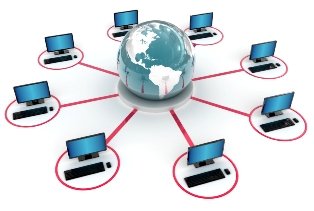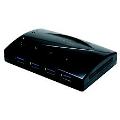Computer Networks is an worldwide, archival academic journal providing a publication vehicle for complete coverage of all topics of interest to those involved in the computer communications networking area. The viewers contain researchers, managers and operators of networks as well as designers and implementers. The leader Board will regard as any material for publication that is of interest to those groups.
A computer network or data network is a telecommunications network that permits computers to replace data. In computer networks, networked computing devices exceed data to each other along data associates. The connections (network links) between nodes are recognized using either cable media or wireless media. The well-known computer network is the Internet.

Network computer campaigns that create, route and terminate the data are called network nodes. Nodes can comprise hosts such as individual computers, phones, servers as well as networking hardware. Two such devices are said to be networked together when one device is able to exchange information with the other device, whether or not they have a straight link to each other.
Computer networking is considered a branch of electrical engineering, telecommunications, computer science, information technology or computer engineering,
SUBJECT COVERAGE OF COMPUTER NETWORKING
1. Communication Network Architectures Of Computer Networking
New plan helps on Local Area Networks (LANs), Metropolitan Area Networks (MANs), Wide Area Networks (WANs) including Wired, Wireless, Mobile, Cellular, Sensor, Optical, IP, ATM, and other linked network technologies, as well as new switching technologies and the addition of a variety of networking paradigms.
2. Communication Network procedures
New devise helps on all protocol layers excluding the Physical Layer, in view of all types of networks mentioned above and their performance assessment; novel protocols, methods and algorithms related to, for example medium access control, error control, routing, resource discovery,
3. Network Services and relevance
Web, Web caching, Web performance, Middleware and operating system sustain for all types of networking, electronic commerce, and quality of service, new adaptive applications, and multimedia services.
4. Network Security and solitude
Security protocols or solitude, authentication, denial of service, anonymity, smartcards, intrusion detection, key management, viruses and other spiteful codes, information flow, data integrity, mobile code and agent security are included in it.
5. Network procedure and organization
In this manner as well as network pricing, network system software, quality of service, signaling protocols, mobility management, power management and power control algorithms, network planning, network dimensioning, network reliability, network performance measurements, network modeling and analysis, and overall system management are including in this.
6. Separate Algorithms and separate Modeling
Algorithmic and separate aspects in the context of computer networking as well as mobile and wireless computing and communications. development the cooperation among practitioners and theoreticians in this field.
Terminology of Computer Networking
Network links
The communication media worn to link devices to form a computer network comprise electrical cable (HomePNA, power line communication, G.hn) and optical fiber (fiber-optic communication), and radio waves (wireless networking). In the OSI model, these are distinct at layers 1 and 2 — the physical layer and the data link layer.
Wired technologies
Twisted pair wire is the most extensively used intermediate for all telecommunication. Coaxial cable is broadly used for cable television systems, office buildings, and other work-sites for local vicinity networks. ITU-T G.hn technology utilizes existing home wiring (coaxial cable, phone lines and power lines) to generate a high-speed (up to 1 Gigabit/s) local area network. An optical fiber is also known as a glass fiber. It utilizes pulses of light to broadcast data. Some compensation of optical fibers over metal wires are very low broadcast loss and immunity from electrical interference.
Wireless technologies
• Terrestrial microwave – Terrestrial microwave communication exercises Earth-based transmitters and recipients like satellite dishes. Terrestrial microwaves be in the low-gigahertz range, which restrictions all communications to line-of-sight.
• Communications satellites – Satellites speaks via microwave radio waves, which are not warded off by the Earth's atmosphere. The satellites are stationed in space, characteristically in geosynchronous orbit 35,400 km (22,000 mi) on the top of the equator. These Earth-orbiting systems are able of receiving and relaying voice, data, and TV signals.
• Cellular and PCS systems exercise numerous radio communications technologies. The systems separate the area covered into manifold geographic areas. Each area has a low-power radio relay antenna device to transmit calls from one area to the next area
Components of computer Networking
 PC - essentially is a personal computer.
PC - essentially is a personal computer.
 NIC - Network Interface Card - This is in cooperation an electrical interface to the router/modem, and a rational board that communicates to the rest of the pc, frequently registered jack forty five or registered jack eleven standard. The cable to give a carrier for the signals is either shielded or unshielded. When you attach to the internet for example the nic should send out fast link pulses that aim to institute the acceptable speed of connection between the modem/router on the global side. These pulses are of a preset length - if one side can react within x number of miliseconds it will communicate at y speed, assuming both sides are set to auto negotiates.NIC has a Media admittance control or a Burned in address inside one of its microchips - this will NEVER modify it can be falsified but it will never actually modify - unless you get a new nic.
NIC - Network Interface Card - This is in cooperation an electrical interface to the router/modem, and a rational board that communicates to the rest of the pc, frequently registered jack forty five or registered jack eleven standard. The cable to give a carrier for the signals is either shielded or unshielded. When you attach to the internet for example the nic should send out fast link pulses that aim to institute the acceptable speed of connection between the modem/router on the global side. These pulses are of a preset length - if one side can react within x number of miliseconds it will communicate at y speed, assuming both sides are set to auto negotiates.NIC has a Media admittance control or a Burned in address inside one of its microchips - this will NEVER modify it can be falsified but it will never actually modify - unless you get a new nic.
 Hub -Seldom used, this holes the connection between multiple PC’s, which may reinforce the signal.
Hub -Seldom used, this holes the connection between multiple PC’s, which may reinforce the signal.
.jpg) Switch –This is used to split multiple pcs into diverse groupings based on logical needs or security needs, within the same subnet or lan
Switch –This is used to split multiple pcs into diverse groupings based on logical needs or security needs, within the same subnet or lan
 Router – This is used to launch data between physical networks.
Router – This is used to launch data between physical networks.
A network is a group of two or more computer systems connected together. There are a lot of types of computer networks, including:
• Local-area networks (LANs) : The computers are organically close together (that is, in the same building).
• Wide-area networks (WANs) : The computers are beyond apart and are associated by telephone lines or radio waves.
• Campus-area networks (CANs): The computers are within a restricted geographic area, such as a campus or military base.
• Metropolitan-area networks MANs): A data network which is designed for a town or city.
• Home-area networks (HANs): A network enclosed within a user's home that connects a person's digital devices.
• Topology: The geometric collection of a computer system. Common topologies comprise a bus, star, and ring.
• Protocol: The protocol describes a common set of rules and signals that computers on the network utilize to communicate. One of the most admired protocols for LANs is called Ethernet. Another accepted LAN protocol for PCs is the IBM token-ring network .
• Architecture: Networks can be generally classified as using either a peer-to-peer or client/server architecture.
.jpg)
Advantages of establishing a School Network
User entrance control. : Modern networks approximately always have one or more servers which allocate centralized management for users and for network sources to which they have access. User recommendation on a privately-owned and operated network might be as simple as a user name and password, but with ever-increasing attention to computing security issues, these servers are critical to ensuring that responsive information is only obtainable to authorized users.
Information amassing and sharing: Computers agree to users to generate and influence information. The network gives both a place to store the information and mechanisms to split that information with other network users.
Connections among the students and teachers: Commissioners, instructors, and even students and guests can be associated using the campus network.
Better Services: The school can supply better services, such as registration, school directories, course schedules, access to research, and email accounts, and numerous others.
Internet: The school can make available network users with access to the internet, via an internet gateway.
Computing sources: The school can offer access to special intention computing devices which individual users would not usually own. For example, a school network might have high-speed high excellence printers strategically located around a campus for instructor or student use.
Flexible Access of network: School networks permit students to access their information from associated devices throughout the school. Students can start on an assignment in their classroom, save part of it on a public access area of the network, then go to the media center after school to close their work. Students can also work considerately through the network.
Workgroup Computing: Mutual software allows many users to work on a document or project concomitantly. For example, educators situated at assorted schools within a county could simultaneously contribute their ideas about new curriculum standards to the same document, spreadsheets, or website.
“Computers are wonderful tools for the apprehension of our dreams, but no machine can substitute the human spark of spirit, compassion, love, and understanding.”